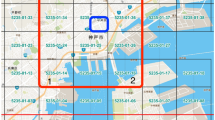Abstract
We propose a method for constructing pedestrian road networks with publicly available geospatial data sets. Our method consists of two algorithms: estimation of road widths and deployment and connection of pedestrian road segments. In the two algorithms, we used two types of geospatial data: the set of road center line segments and the set of road edge segments. The experimental results show that the estimation algorithm of road widths can calculate precise road widths and the construction algorithm of pedestrian road networks works well even for road networks with a complicated connecting relationship.
Access this chapter
Tax calculation will be finalised at checkout
Purchases are for personal use only
Similar content being viewed by others
Notes
- 1.
The explanation of tags is described as “;;\(\cdots \)”. These comments are not included in the original data.
References
Chen, X., Zhan, F.B.: Agent-based modelling and simulation of urban evacuation: relative effectiveness of simultaneous and staged evacuation strategies. J. Oper. Res. Soc. 59(1), 25–33 (2008)
City of Nagoya: Earthquake hazard maps in nagoya. http://www.city.nagoya.jp/bosaikikikanri/page/0000057008.html. [in Japanese]
D’Orazio, M., Spalazzi, L., Quagliarini, E., Bernardini, G.: Agent-based model for earthquake pedestrians’ evacuation in urban outdoor scenarios: behavioural patterns definition and evacuation paths choice. Saf. Sci. 62, 450–465 (2014)
Google LLC: Google maps. https://www.google.com/
GSI: Geospatial information authority of Japan. http://www.gsi.go.jp/. [in Japanese]
GSI: Portal for hazard maps. https://disaportal.gsi.go.jp/. [in Japanese]
Lämmel, G., Rieser, M., Nagel, K.: Large scale microscopic evacuation simulation. Pedestr. Evacuation Dyn. 2008, 547–553 (2010)
Madireddy, M., Medeiros, D.J., Kumara, S.: An agent based model for evacuation traffic management. In: Proceedings of the Winter Simulation Conference, WSC ’11, pp. 222–233 (2011)
Wang, H., Mostafizi, A., Cramer, L.A., Cox, D., Park, H.: An agent-based model of a multimodal near-field tsunami evacuation: decision-making and life safety. Transp. Res. Part C: Emerg. Technol. 64, 86–100 (2016)
Author information
Authors and Affiliations
Corresponding author
Editor information
Editors and Affiliations
Rights and permissions
Copyright information
© 2019 Springer Nature Singapore Pte Ltd.
About this paper
Cite this paper
Asakura, K., Ikeya, Y., Watanabe, T. (2019). A Construction Method of Pedestrian Road Networks for Agent-Based Evacuation Simulation. In: Chen, YW., Zimmermann, A., Howlett, R., Jain, L. (eds) Innovation in Medicine and Healthcare Systems, and Multimedia. Smart Innovation, Systems and Technologies, vol 145. Springer, Singapore. https://doi.org/10.1007/978-981-13-8566-7_52
Download citation
DOI: https://doi.org/10.1007/978-981-13-8566-7_52
Published:
Publisher Name: Springer, Singapore
Print ISBN: 978-981-13-8565-0
Online ISBN: 978-981-13-8566-7
eBook Packages: Intelligent Technologies and RoboticsIntelligent Technologies and Robotics (R0)




